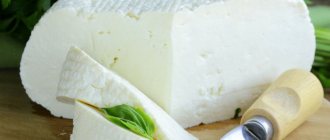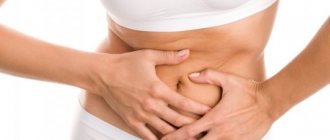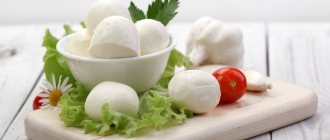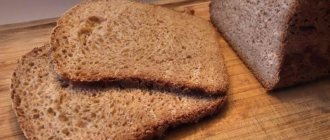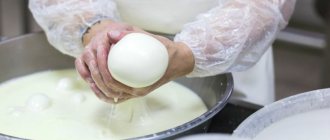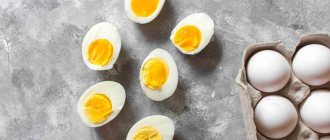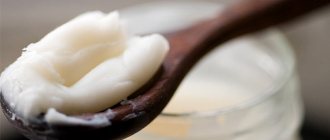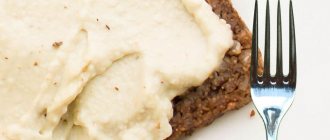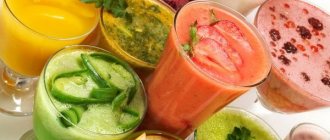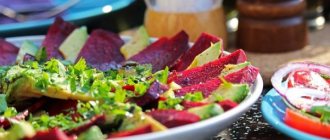Oh, this France! Champagne and Roquefort, cognac and choucroute, Armagnac and Camembert, onion soup and bouillabaisse - all this was given to the world by French masters of culinary art and winemaking. This list can be continued endlessly. In the words of the great philosopher and thinker who lived during the Enlightenment, Jean-Jacques Rousseau: “a lifetime, perhaps, would not be enough to taste all the masterpieces served on the table during meals in my great country.”
But the list of dishes and delicacies would not be complete without one more dish, originally from France. Pate is at the same time simple and elegant, multi-faceted and easily recognizable dish.
Pate
And in fact, can a mass that is sold in small cans be called a real pate - you can find such a product in any supermarket.
In Russia, pate was tried in the 18th century, and at first chefs were invited from France to prepare it - of course, only aristocrats could afford it. Today, few people remember that in his “Onegin” Pushkin describes “Strasbourg’s imperishable pie” - when we read these lines at school, we hardly thought that the author was referring specifically to pate - however, one of those products that we are only talking about today we hear: it included hazel grouse, truffles, and other elite products - few of us even tried them.
The word "pate" comes from the word "pasta" - this is Latin, and means something like "pureed (or crushed) and wrapped in dough" - something like that - so the pie was called pate.
Beef liver pate for the winter in jars
You will need:
- beef liver - 2 kg;
- pork lard - 250 g;
- dry herbs - 2g;
- onion - 90 g;
- fresh greens - 10 g;
- nutmeg - 2 g;
- ground cloves - 0.5 g;
- coriander - 1g;
- garlic pepper - 1 g;
- salt - 2 g;
- mixture of dry herbs - 3 g.
The pate can be preserved for the winter
. Preparation:
- Before you start cooking, you need to wash the liver, cut it into thin slices, and carefully inspect it so that there are no remaining bile. Soak in 3 liters of cold water.
- After 4.5 hours, drain it and remove the remaining water with a paper napkin.
- In hot lard, thoroughly fry the pieces of liver until dark brown.
- Chop the onion into thin strips and lightly fry over high heat for 2 minutes.
- Grind the liver in a meat grinder. Add onion, spices to it and grind everything again.
- Pour hot pate into sterilized jars in portions, not reaching 2 cm from the edges.
- Cover the jars with lids and sterilize for 1.5 hours.
- Roll up the jars and cool them in the cold.
What types of pates are there?
In fact, there are different types of pates, and we don’t know about some of them at all. Pate baked in dough
the French cooked in such a way that the dough could then be thrown away - this was wastefulness, especially in the 18th century, when the people of France often went hungry, but such were aristocratic whims. The filling was minced meat mixed with herbs, vegetables, fats, and later pates began to be prepared from the meat of small birds and other ingredients, and they learned to bake them in foil or special forms; They ate pates hot and cold.
Why I love my robot vacuum cleaner so much: sharing my own experience
Another variety is stewed pate
, and it was usually made from pork - most likely, it was invented even earlier. The French called the pate “Rillon”, and it must contain pork - this is the main component, as well as less fatty meat - hare, poultry, etc. The meat is stewed for a long time with seasonings and spices, and then poured into pots or bowls , and for several weeks they are put in a cold place - a glacier: this is what ice cellars used to be called, and it must be said that the food in them was preserved much longer than in modern refrigerators, and did not lose its quality. It is easy to notice that this is a less refined dish, and in general it is somewhat reminiscent of our stew or jelly - it was loved by wealthy French peasants and rich bourgeois.
Pate prepared in pots - terrine
, on the contrary, is distinguished by its “delicacy” - no additives are used in its preparation: in addition to minced meat of various varieties, these are mushrooms, herbs and spices, pickles, lingonberries, pineapples, oranges, cherries, juniper berries, and even alcoholic ingredients - armagnac, etc. These pates are baked in the oven in different pots - glass and ceramic, and they are also cooked in a water bath, and fat or jelly is poured on top.
Terrine pates can be not only meat: they are made from fish, seafood, mushrooms and vegetables, and even sweet products - here French chefs set no limits for imagination.
What do we call pate?
Today we have begun to learn more, but earlier, in “Soviet” times, pates called exactly what is still sold in jars today - a carefully crushed mass, almost a puree, usually from liver, or with the addition of meat. Such pates are made from already prepared products (fried, boiled, stewed), and are crushed using various meat grinders, food processors, rubbed through a sieve, etc.
At home you can make pates from any product: classic - from liver; from pork and chicken, from cheese and fish, their green vegetables and potatoes, mushrooms and fruits - of course, such pates cannot be stored - they must be eaten within a few hours.
The world-famous dish - foie gras pate - made from fatty liver, mainly duck and goose, was invented in the last quarter of the 18th century by a French chef who served the mayor of Strasbourg - hence the name “Strasbourg pie”. Experts, however, believe that similar pates were prepared before, and the cook just slightly changed the recipe - and the appetizer quickly became famous. We won’t talk here about the intricacies of cooking foie gras, and especially about raising birds for it - enough has been written about this today. We will try to talk a little about the pate that you can buy from us today, as well as about preparing pates at home - with modern kitchen appliances this is not at all difficult.
Cooking secrets
Beef liver pate will turn out to be a tender and tasty dish that everyone at home will appreciate if you know the secrets of cooking.
Before preparing the liver, you need to not only wash it, but carefully examine it in cross-section under bright light. Traces of bile and large blood clots may remain in the ducts, which will spoil the taste of the finished product. Now about the cooking secrets that will make the dish not only tasty, but also help preserve its beneficial properties.
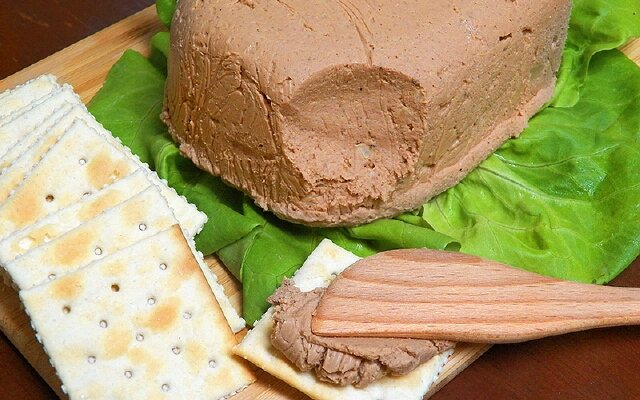
Liver pate recipe
- The best pieces are those from the edge. They are the most tender, cook faster, and are perfect for frying in a pan.
- Externally, the liver should be red-brown in color, elastic to the touch, without depressions or convex lumps.
- Don't forget to remove the films before cooking. This point can be neglected, but the liver will be hard after boiling or frying.
- Cold water with soda or milk will help remove the specific smell and make the beef liver softer.
- Liver pates are best eaten cold. There will be enough fat from the beef liver to keep it from completely congealing.
- Fragrant spices, garlic and onions best complement the taste of the finished product.
- If you boil the liver for 7-8 minutes in salted water, it will become softer for frying and the cooking time will be halved.
Beef liver pate is not only a wonderful appetizer on soft bread. A roll cut into appetizing slices with sprigs of herbs and a thin pattern of butter will be the main dish on the holiday table. It is served in most European countries with wine as a separate dish.
The pate can be eaten not only in the form of a roll, but also prepared for the winter by canning the finished product, richly flavored with lard, in jars. There is even a special diet based on light pate and vegetables, which, thanks to a balanced diet and low calorie content, helps you lose up to 5 kg per week.
The benefits and harms of pate
Is pate healthy or harmful as a food product?
Opinions, as always, are divided, but one thing can be said for sure: pate is a real product made from natural ingredients, which means it has benefits - it just depends on the method of preparation and storage conditions, if the pate must be stored for some time time. In Russia, pates are usually prepared from the liver of livestock and poultry, and these products are very rich in vitamins - in particular vitamin A; minerals and many other nutrients; They also have a lot of calories, but they are not heavy on the stomach like meat or fat.
Therefore, many nutritionists recommend eating pates even for breakfast - little by little, in the form of sandwiches or with salads - after this there will be no heaviness in the stomach, but the feeling of fullness will remain for many hours.
With added mushrooms
You will need:
- beef liver - 750 g;
- medium champignons - 220 g;
- sweet cream butter 82% - 120 g;
- onion - 90 g;
- vegetable oil - 60 g;
- mixture of herbs - 7 g;
- garlic pepper - 2 g;
- carrots - 90 g;
- fresh greens - 40 g.
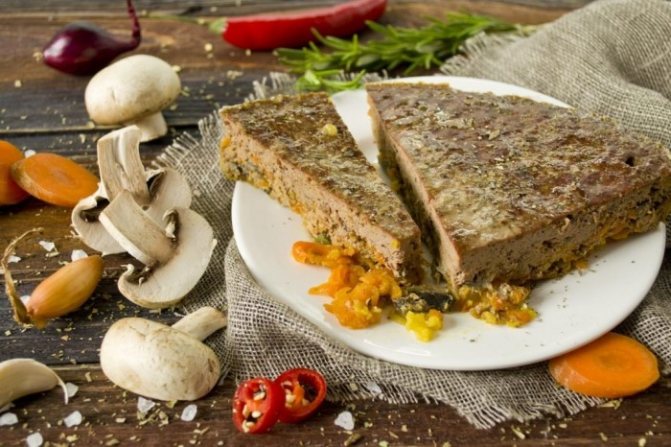
Preparation:
- Pour aromatic sunflower oil into a frying pan, add chopped onions, grated carrots and fry over high heat for 3 minutes.
- Wash the champignons thoroughly, cut into slices and add to the vegetables.
- Rinse the liver with cool running water, cut into thin strips, and place in a roasting pan. Fry over high heat for 25 minutes.
- Using a food processor, pulse all ingredients except mushrooms once.
- Add the oil to the ground liver with vegetables and grind everything until plastic.
- Add pieces of fried mushrooms. Leave the pate in the cold for 7 hours.
How to choose a pate
If you do not prepare pate, but buy it in a store, you need to know how to choose it
. Traditionally, pate is packaged in cans, and it can be stored for several years - no preservatives are needed for this, but today the packaging has changed - manufacturers are trying to minimize costs. The pates are packaged in polymer shells, and their shelf life is sharply reduced: a month at most; if the packaging indicates that it can be stored for six months or more, this means that the manufacturer did not spare any preservatives.
Opened pate can be stored in the refrigerator for a maximum of 5 days. The liver in the pate should be 55% or more: usually it is beef liver or poultry liver.
The jar with the pate should be smooth and neat, without streaks, and the pate itself should have a uniform consistency and light brown color (it may be slightly grayish or beige - this is normal). The beautiful pink or dark brown color of the product indicates that it contains a lot of dyes and other additives, but a good pate has only 5 main ingredients: liver, meat, salt, butter and spices - this product is produced in accordance with GOST 12139-77. The “correct” pate smells like natural spices, but the taste may be slightly bitter - this is typical for any liver products.
Dietary beef liver pate
You will need:
- beef liver - 0.5 kg;
- milk - 0.7 l;
- carrots - 0.120 kg;
- onions - 0.300 kg;
- butter 82% - 0.120 kg;
- vegetable oil - 0.06 kg;
- nutmeg - 1 g;
- ground cloves - 1 g;
- bay leaf - 2 pcs.;
- salt - 5 g.
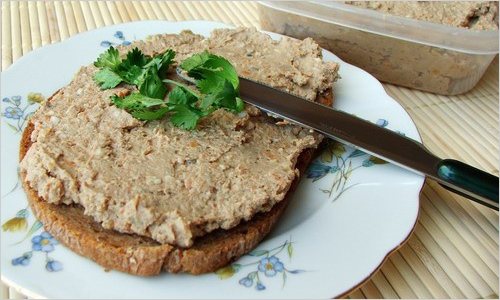
Preparation:
- Before you start preparing the dish, you need to take the liver, wash it well and soak in milk. Place the container in a cool place for 6 hours.
- Take out the soaked liver, put it in a deep saucepan, add spices and add water so that it covers all the pieces. Leave over high heat for 25 minutes, checking periodically to ensure the water does not boil away.
- After boiling, foam will begin to appear; it must be carefully removed, closed with a lid, and left to simmer for another 15 minutes. During cooking, check that there is enough water and remove foam if it appears.
- Pour chopped onions and carrots into a heated frying pan, pour in oil and, without reducing the heat, fry for 6 minutes until light golden brown.
- Transfer the boiled liver into a container for an immersion blender, add the fried vegetables there and grind everything.
- Before placing the finished dish in the refrigerator, add warm butter to soften the pate.
Homemade pate
As already said, it is quite easy to prepare pate at home today, but we will not give recipes for meat pates here: everyone is used to eating them, and such recipes are not difficult to find, besides, we already consume a lot of meat - such is the food culture that has developed in Russia today .
There is an amazingly healthy and even medicinal product - zucchini, and the pate they make is wonderful, light and very tasty. A couple of ripe zucchini should be cut into slices, fried together with onion (1 large onion), add 3 crushed cloves of garlic, cool slightly and puree in a blender. Then add the remaining ingredients: mascarpone or just your favorite cheese, grated on a fine grater (150 g), toasted and chopped almonds (50 g) and 1 tbsp. low-fat mayonnaise. Mix everything thoroughly and refrigerate for half an hour. You can serve it on a plate, on toast or croutons.
You can prepare pates from onions and cucumbers, nuts, cheese and bell peppers, green leafy vegetables and edible herbs, beets, cheese and garlic, tomatoes and eggs, and mushroom pate turns out to be so tasty and piquant that few people believe that it was prepared without meat. Of course, you should also know how to cook meat pates, and most importantly, eat them correctly, enjoying their taste and receiving only benefits.
Article protected by copyright and related rights. When using or reprinting material, an active link to the women's website inmoment.ru is required!
Classic beef liver pate
You will need:
- beef liver - 450 g;
- pork pulp -150 g;
- milk - 80 g;
- onion - 80 g;
- butter 72% - 130 g;
- pork lard - 125 g;
- carrots - 100 g;
- ground cloves - 1.5 g;
- chicken egg - 1 pc.
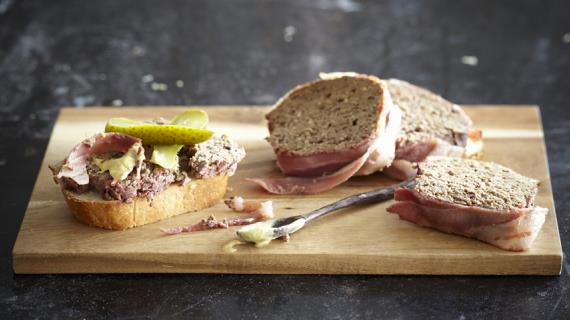
Preparation:
- Cut the pulp into pieces, chop the carrots and onions into thin strips.
- Heat a deep frying pan or roasting pan and pour in the meat. Fry until golden brown in lard.
- 25 minutes after the start of frying, add chopped carrots and onions, lightly salt and add spices.
- After the meat is fried, add milk and simmer over low heat for 45-50 minutes.
- Place the liver into the stewed pulp and leave to simmer over low heat for 20 minutes.
- Set the pan aside and let the ingredients cool.
- Using a food processor or meat grinder, make a homogeneous pate, mix with butter at the end. This will make the consistency softer; garnish the finished dish with grated boiled egg.
Benefits for women
Many women know about the beneficial properties of liver and regularly include it in their diet, because it helps maintain youthful skin, hair and nails thanks to the high content of vitamins A and E. This product is also famous for increasing the level of hemoglobin in the blood and thereby reducing the risk of the occurrence of anemia.
In addition, it is difficult to imagine another delicacy that would be as suitable for a diet menu as liver.
Is it possible for pregnant and nursing mothers
Beef liver has a number of characteristics that make it useful for both expectant mothers and women during lactation:
- vitamins A and E help maintain healthy skin and hair, and also help avoid stretch marks on the body;
- the product allows you to speed up metabolism and reduce the risk of toxicosis and constipation;
- folic acid provides conditions for the proper development of the fetus.
Attention! If you are pregnant or nursing an infant, it is recommended that you consult your doctor before introducing liver into your diet.
I also advise you not to forget about the simplest rules of cooking during such a delicate period of a woman’s life: the liver must be fresh and heat-treated for at least 10 minutes.
Benefits for children
Beef liver is an important element in children's diets. Naturally, it can be introduced into the child’s menu only when the baby is 6-7 months old and after consultation with a pediatrician.
The product is useful for a growing organism due to the following characteristics:
- vitamin C strengthens the immune system;
- vitamin PP makes the walls of blood vessels stronger, which means it can reduce the risk of nosebleeds in children;
- calcium strengthens bones;
- amino acids and proteins help speed up tissue regeneration, enhance the body’s ability to resist bacteria and viruses;
- Due to the increase in hemoglobin, the baby’s brain activity improves and his memory develops;
- vitamin B helps the nervous system function properly, which means the child will fall asleep faster and his sleep will become more sound;
- Magnesium and potassium contribute to the normal development of the cardiovascular system.
The best place to start getting acquainted with liver is with pate. It’s not difficult to prepare: just boil the product well and then grind it using an immersion blender. If you wish, you can add your baby’s favorite vegetables to it - the taste of the dish will immediately become more attractive, and the benefits will only increase.
As for serving sizes, at first you should limit yourself to a couple of tablespoons, then, if the child likes the dish, the serving can be increased to 50-60 g per day.
Important! Carefully monitor your baby's reaction to a new product. If you notice an allergy or any other deterioration in your condition, it is better to forget about the liver for a while.
Benefits for the body
Of course, the benefits of any product for our health are manifested not only in energy value, but also in the overall positive effect on the body.
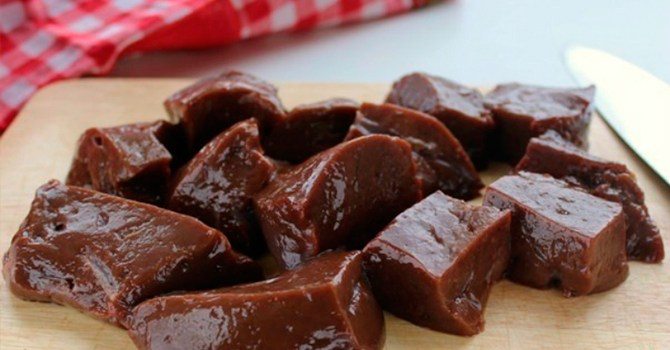
What is the main value of beef liver?
- The product helps thin the blood, so it is recommended to use it to reduce the risk of blood clots, as well as to prevent varicose veins.
- Has a diuretic effect.
- Proteins and amino acids help strengthen muscles and tissues.
- The presence of vitamin A helps maintain youthful skin and the body as a whole.
- Phosphorus and magnesium help maintain efficient brain function, improve memory and promote concentration.
- The low calorie content makes the product ideal for a diet menu.
- Due to the presence of chromium, liver can lower the amount of sugar in the blood, which means it is recommended for consumption even by those diagnosed with diabetes.
Chemical composition
Beef liver, like veal liver, is rich in vitamins and beneficial microelements. The first place in this list belongs to B vitamins, which help the proper functioning of the nervous system and normalization of metabolism.
It is believed that even one serving of offal is enough to provide our body with a complete daily requirement of vitamins such as A, E, C, D.
The delicacy also includes:
- potassium;
- sodium;
- magnesium;
- iron;
- zinc;
- fluorine and others.
